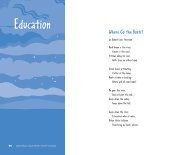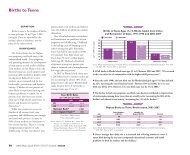2010 Rhode Island Kids Count Factbook
2010 Rhode Island Kids Count Factbook
2010 Rhode Island Kids Count Factbook
Create successful ePaper yourself
Turn your PDF publications into a flip-book with our unique Google optimized e-Paper software.
Breastfeeding<br />
DEFINITION<br />
Breastfeeding is the percentage of<br />
newborn infants who are exclusively<br />
breastfed at the time of hospital<br />
discharge.<br />
SIGNIFICANCE<br />
The American Academy of Pediatrics<br />
(AAP) identifies breastfeeding as the<br />
ideal method of feeding and nurturing<br />
infants and recognizes breastfeeding as a<br />
critical component in achieving optimal<br />
infant and child health, growth and<br />
development. The AAP recommends<br />
exclusive breastfeeding for six months<br />
after birth, continuous breastfeeding for<br />
at least 12 months after birth, and<br />
thereafter as long as mutually desired. 1<br />
Breastfeeding decreases infant<br />
mortality and morbidity. 2 Benefits for<br />
infants include optimal nutrition,<br />
reduced risk for sudden infant death<br />
syndrome (SIDS) as well as reduced risk<br />
for chronic conditions such as obesity,<br />
type 1 and 2 diabetes and childhood<br />
leukemia. Additionally, breastfeeding<br />
benefits mothers by creating a strong<br />
bond with infants and decreasing risk<br />
for postpartum depression, type 2<br />
diabetes, breast and ovarian cancer. 3<br />
Breastfeeding provides significant social<br />
and economic benefits including<br />
reduced cost to the family, reduced<br />
health care costs and reduced employee<br />
absenteeism. 4<br />
Breastfeeding can be effectively<br />
100<br />
90<br />
80<br />
70<br />
60<br />
50<br />
40<br />
30<br />
20<br />
and Formula Feeding Rates in <strong>Rhode</strong> <strong>Island</strong>, 2004-2008<br />
promoted by practices that take place<br />
10<br />
before, during, and after labor and Breastfeeding<br />
0<br />
delivery. 5 Educating new mothers and<br />
<strong>2010</strong> target. 12 others. <strong>Rhode</strong> <strong>Island</strong> does not have legislation that mandates support for breastfeeding<br />
women of childbearing age about<br />
Exclusive Breastfeeding Both Exclusive Formula Feeding<br />
100%<br />
breastfeeding is instrumental to<br />
90%<br />
28%<br />
27%<br />
27%<br />
increasing practice initiation. Hospital<br />
80%<br />
and other birth facility policies and<br />
70%<br />
6%<br />
practices influence the success of<br />
20%<br />
13%<br />
60%<br />
64%<br />
breastfeeding. 6 Access to professional<br />
50%<br />
57%<br />
lactation consultants, involvement in<br />
mother-to-mother lactation support<br />
networks, and birth facility support for<br />
breastfeeding all factor into protecting,<br />
40%<br />
30%<br />
20%<br />
10%<br />
49%<br />
supporting and promoting<br />
0%<br />
Core Cities<br />
Remainder of State<br />
<strong>Rhode</strong> <strong>Island</strong><br />
breastfeeding. 7 Without adequate<br />
Source: <strong>Rhode</strong> <strong>Island</strong> Department of Health, Center for Health Data and Analysis, Newborn Developmental Risk<br />
support, women are more likely to stop Screening Program, 2004-2008. Breastfeeding and formula feeding are defined as intended feeding method at hospital<br />
breastfeeding earlier. 8 Certain social<br />
discharge. Core cities are Central Falls, Newport, Pawtucket, Providence, West Warwick, and Woonsocket. Totals may<br />
not sum to 100% because data on feeding methods were not available on 3% of births.<br />
determinants also influence exclusivity<br />
and duration of breastfeeding.<br />
Breastfeeding rates generally increase<br />
with maternal age, higher educational<br />
achievement and higher income levels. 9<br />
◆ Nationally in 2007, Hispanic children were the most likely to have ever been breastfed,<br />
followed by Asian and Native American children. 13 Nationally, non-Hispanic black<br />
children are the least likely to have been breastfed, although significant increases in<br />
breastfeeding rates have occurred in this group since the mid-1990s. 14<br />
Healthy People <strong>2010</strong>, the nation’s<br />
health agenda, established target<br />
breastfeeding rates of 75% at birth,<br />
50% at 6 months and 25% at one<br />
year. 10 <strong>Rhode</strong> <strong>Island</strong> exceeded the<br />
◆ Between 2004 and 2008, more than half (57%) of all women who gave birth in <strong>Rhode</strong><br />
<strong>Island</strong> chose to exclusively breastfeed their children, nearly one-third (27%) chose to<br />
exclusively formula feed, 13% chose to use a combination of breast and formula feeding<br />
and data on feeding method was not available for 3% of births. 15<br />
Healthy People <strong>2010</strong> goal with 75% of<br />
infants born in 2006 having ever been<br />
breastfed. 11 Nationally, the percentage of<br />
infants who were ever breastfed has<br />
◆ Of new mothers in <strong>Rhode</strong> <strong>Island</strong> between 2004 and 2008 who were surveyed<br />
approximately 3 months after giving birth, 73% reported having ever breastfed. Fifty-two<br />
percent of these mothers reported continued breastfeeding at the time of the survey. 16<br />
significantly increased from 60% among<br />
infants born in 1993-1994 to 77%<br />
among infants born between 2005-<br />
2006, which exceeds the Healthy People<br />
◆ In 2008, the <strong>Rhode</strong> <strong>Island</strong> General Assembly enacted a law that provides mothers with<br />
the explicit right to breastfeed in public places. Despite protective laws, mothers and<br />
babies who breastfeed in public can still face obstacles and negative reactions from<br />
mothers who return to work, as do fifteen other states. 17<br />
62 <strong>2010</strong> <strong>Rhode</strong> <strong>Island</strong> KIDS COUNT <strong>Factbook</strong> / Health






